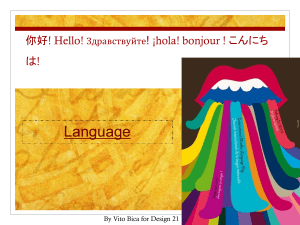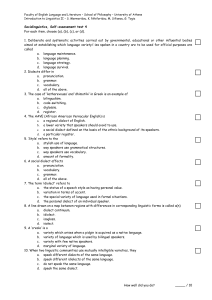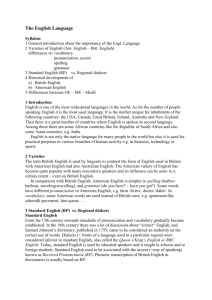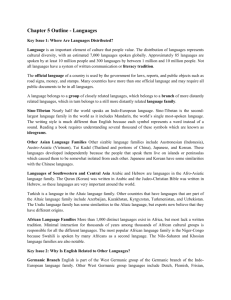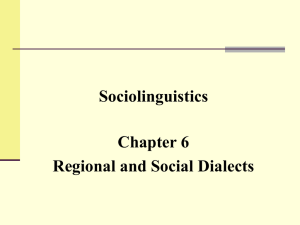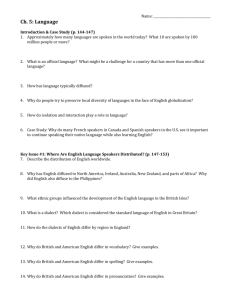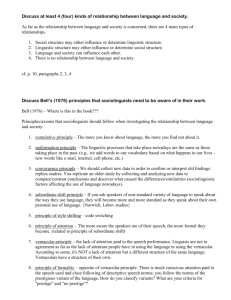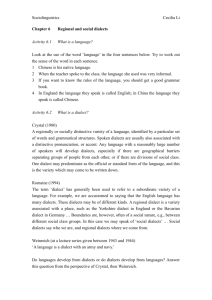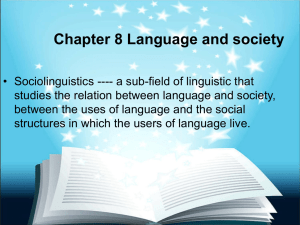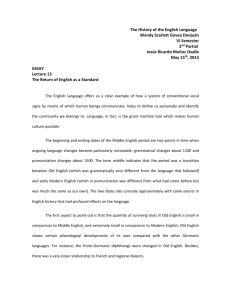AP Human Geography: Language Variation & Preservation Notes
advertisement
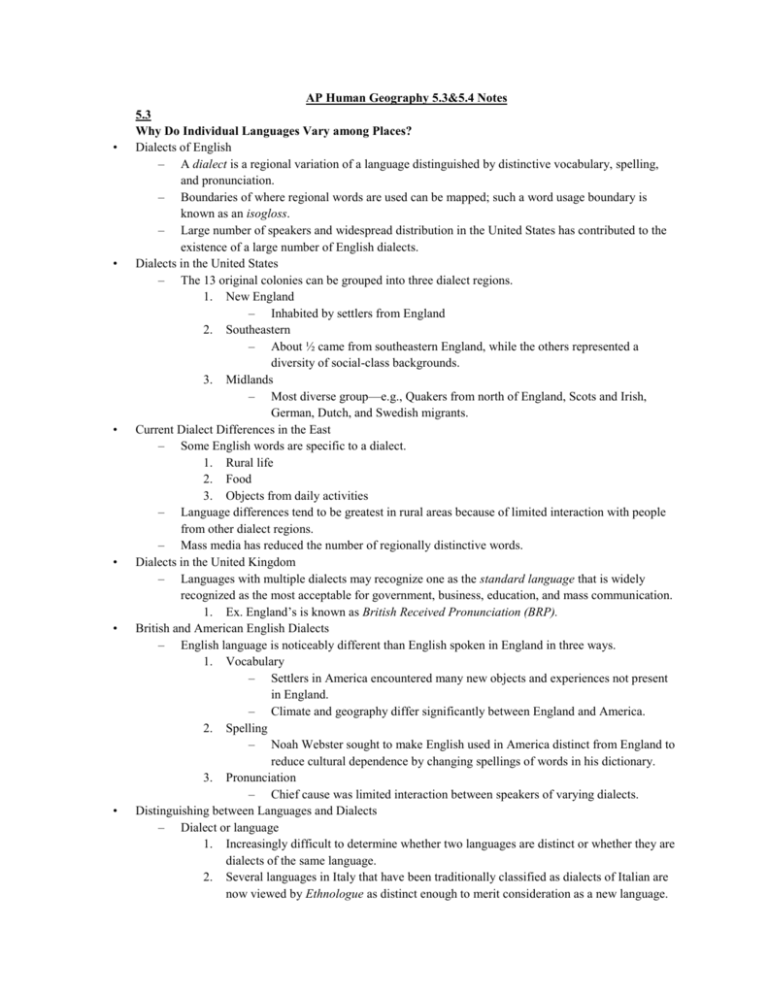
• • • • • • AP Human Geography 5.3&5.4 Notes 5.3 Why Do Individual Languages Vary among Places? Dialects of English – A dialect is a regional variation of a language distinguished by distinctive vocabulary, spelling, and pronunciation. – Boundaries of where regional words are used can be mapped; such a word usage boundary is known as an isogloss. – Large number of speakers and widespread distribution in the United States has contributed to the existence of a large number of English dialects. Dialects in the United States – The 13 original colonies can be grouped into three dialect regions. 1. New England – Inhabited by settlers from England 2. Southeastern – About ½ came from southeastern England, while the others represented a diversity of social-class backgrounds. 3. Midlands – Most diverse group—e.g., Quakers from north of England, Scots and Irish, German, Dutch, and Swedish migrants. Current Dialect Differences in the East – Some English words are specific to a dialect. 1. Rural life 2. Food 3. Objects from daily activities – Language differences tend to be greatest in rural areas because of limited interaction with people from other dialect regions. – Mass media has reduced the number of regionally distinctive words. Dialects in the United Kingdom – Languages with multiple dialects may recognize one as the standard language that is widely recognized as the most acceptable for government, business, education, and mass communication. 1. Ex. England’s is known as British Received Pronunciation (BRP). British and American English Dialects – English language is noticeably different than English spoken in England in three ways. 1. Vocabulary – Settlers in America encountered many new objects and experiences not present in England. – Climate and geography differ significantly between England and America. 2. Spelling – Noah Webster sought to make English used in America distinct from England to reduce cultural dependence by changing spellings of words in his dictionary. 3. Pronunciation – Chief cause was limited interaction between speakers of varying dialects. Distinguishing between Languages and Dialects – Dialect or language 1. Increasingly difficult to determine whether two languages are distinct or whether they are dialects of the same language. 2. Several languages in Italy that have been traditionally classified as dialects of Italian are now viewed by Ethnologue as distinct enough to merit consideration as a new language. – Examples include Emiliano-Romagnolo, Liguri, Lombard, and Sicilian. 5.4 Why Do People Preserve Local Languages? • Language Diversity – Difficulties can arise at the boundary between two languages. 1. Varying degrees of difficulties – Belgium » Southern Belgians (Walloons) speak French. » Northern Belgians (Flemings) speak Flemish. » Pressure from Flemish speakers led to the division of Belgium into two independent regions with each controlling their own cultural affairs, public health, road construction, and urban development. – Switzerland » Cont’d on next slide. 2. Varying degrees of difficulties – Switzerland » Peacefully exists with multiple languages. » Switzerland attributes success to decentralized government, in which local authorities hold most of the power, and decisions are frequently made on a local level by voter referenda. » Four official languages—German (65%), French (18%), Italian (10%), and Romansh (1%) • Isolated Languages – An isolated language is one unrelated to any other and therefore not attached to any language family. 1. Arise from lack of interaction with speakers of other languages. 2. Ex. Basque in Europe – Only language currently spoken that survives since the period before the arrival of Indo-European speakers. – First language of 666,000 people in the Pyrenees Mountains of northern Spain and southwestern France. » Mountain chain serving as a natural barrier to diffusion helped them preserve their language. 3. Ex. Icelandic – Language has changed less than any other Germanic language. • Extinct and Revived Languages – An extinct language is one that is no longer spoken or read in daily activities by anyone in the world. 1. Presently, 473 languages nearly extinct – 46 in Africa – 182 in Americas – 84 in Asia – 9 in Europe – 152 in Pacific 2. Ex. Native Americans – 74 languages extinct in the United States that were once spoken by Native Americans. • Preserving Endangered Languages: Celtic – Linguists expect hundreds of languages will become extinct during the twenty-first century. 1. Only about 300 languages are said to be safe from extinction. Celtic Language 1. Significant to English speakers because of its primacy in the British Isles. 2. Survives only in remote parts of Scotland, Wales, and Ireland, and on the Brittany peninsula of France. 3. Celtic speakers must work hard to preserve their language in face of diffusion by others who have greater political and economic strength. Global Dominance of English – A lingua franca is a language of international communication. 1. Ex. English – First language of 328 million people – Spoken fluently by another ½ to 1 billion people. – Official language in 57 countries – People in smaller countries learn English to participate more fully in the global economy and culture. 2. Other Examples – Swahili in East Africa – Hindi in South Asia – Indonesian in Southeast Asia – Russian in former Soviet Union. – English on the Internet 1. Majority of content on Internet is in English. – Dominance of content in English is waning. » Percentage of English-language online users declined from 46 percent in 2000 to 27 percent in 2010. – Mandarin will likely replace English as the most-frequently used online language before 2020. – Expansion Diffusion of English 1. Recent growth in the use of English is an example of expansion diffusion—the spread of a trait through the snowballing effect of an idea. 2. Expansion has occurred in two ways with English. – English is changing through diffusion of new vocabulary, spelling, and pronunciation. – English words are fusing with other languages. » Ex. Words, such as cowboy, hamburger, jeans, and T-shirt were allowed to diffuse into French. » Ex. English words have spurred the creation of English-like words to replace traditional Spanish words, such as parquin (Spanglish) for estacionamiento (Spanish) Spanish and French in the United States and Canada – Spanish 1. Increasingly important language in recent years in United States because of large-scale immigration from Latin America. – Some communities now issue public notices, government documents, and advertisements in Spanish. – Radio stations and TV now broadcast in Spanish in places where most of the 35 million Spanish speakers live. 2. In reaction, 30 states and number of localities have laws making English the official language. – • • – – Some courts have judged these laws to be unconstitutional restrictions on free speech. French 1. Québec government has made the use of French mandatory in many daily activities. 2. Québec faces challenges integrating a large number of immigrants from Europe, Asia, and Latin America who don’t speak French. – Immigrants prefer to use English as the lingua franca because of its greater global usage.

